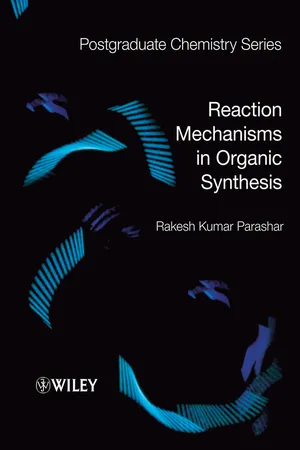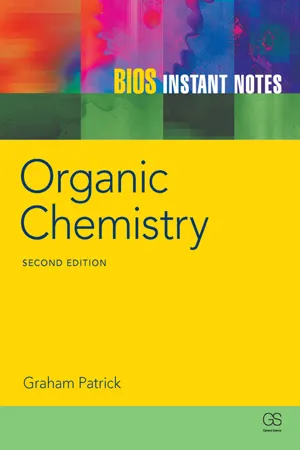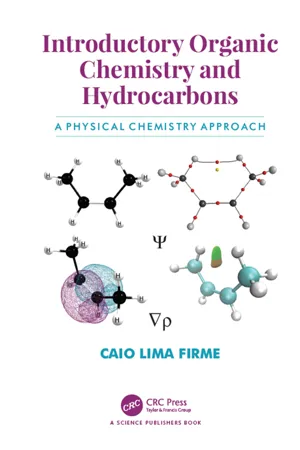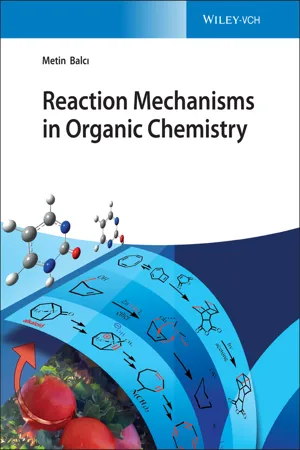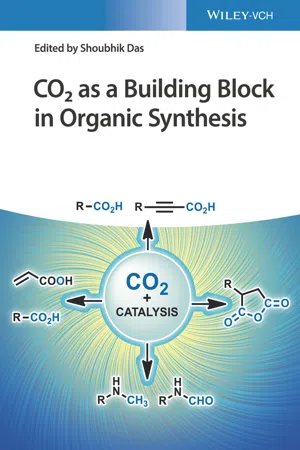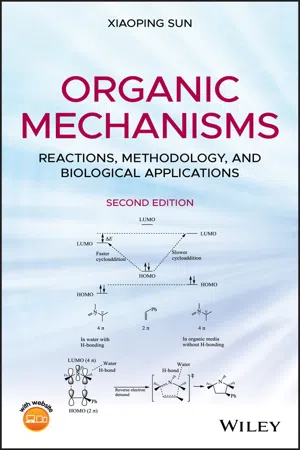Chemistry
Synthesis of Alkenes
The synthesis of alkenes involves the creation of carbon-carbon double bonds. This can be achieved through several methods, including elimination reactions of alkyl halides, dehydration of alcohols, and dehydrohalogenation of alkyl halides. These processes result in the formation of alkenes, which are important building blocks in organic chemistry.
Written by Perlego with AI-assistance
Related key terms
Related key terms
1 of 4
Related key terms
1 of 3
6 Key excerpts on "Synthesis of Alkenes"
- eBook - ePub
- Rakesh Kumar Parashar(Author)
- 2013(Publication Date)
- Wiley-Blackwell(Publisher)
Chapter 4
Carbon–Carbon Double Bond Forming Reactions
4.1 Introduction
Alkene synthesis is the most important and most widely used reaction in organic chemistry. Many review articles and research papers describe methods for the positioning and stereospecific introduction of carbon–carbon double bonds1–3 . The three most important methods for the Synthesis of Alkenes described in this chapter are (1) elimination reactions, (2) alkenation of carbonyl compounds and (3) reduction of alkynes.4.2 Elimination reactions
In an elimination reaction the carbon skeleton is pre-assembled. There can be two problems, namely the positioning of the double bond and that of double bond geometry.4.2.1 β-Eliminations
When 2-bromopropane (4.1) is allowed to react with the methoxide ion in methanol, only 40% of the starting material is converted into methyl isopropyl ether (4.2) (substitution) and the rest (60%) is transformed into propene (4.3) (elimination). Substitution and elimination are often competitive processes. The reaction that produces the alkene involves the loss of an HBr molecule to form a carbon–carbon double bond.In the E2 elimination reaction of alkyl halides (one-step reaction) a base abstracts a proton adjacent to the leaving group, forcing the removal of the leaving group with the formation of a double bond (Scheme 4.1 ).Scheme 4.1The E2 dehydrohalogenation of alkyl halides is periplanar and occurs most favourably with the proton and halide in an anti -configuration. The formation of the E - or Z -alkene depends on which diastereomer is undergoing elimination. Thus, erythro -alkyl halide 4.4 gives trans -alkene 4.5, and threo -alkyl halide 4.6 gives cis -alkene 4.7 (Scheme 4.2 ).Scheme 4.2However, a unimolecular E1 reaction undergoes elimination reactions via the formation of the carbocation. It is this step of the reaction that is rate limiting . In this case the solvent then acts in the next step of the reaction as the base, removing an H+ ion from one of the alkyl groups adjacent to the carbocation. The electrons in the C–H bond that is broken are donated to the empty orbital on the carbocation to form a double bond (Scheme 4.3 ). Thus, alcohols can be dehydrated on heating with 85% H3 PO4 or 20% H2 SO4 to alkenes or on heating with KHSO4 - eBook - ePub
- Graham Patrick(Author)
- 2004(Publication Date)
- Taylor & Francis(Publisher)
Figure 1. Synthesis of an alkene from a vicinal dibromide. Figure 2. Synthesis of an alkyne from an alkene.Alkynes
Alkynes can be synthesized from alkenes through a two-step process which involves the electrophilic addition of bromine to form a vicinal dibromide (Section H3 ) then dehydrohalogenation with strong base (Figure 2 ). The second stage involves the loss of two molecules of hydrogen bromide and so two equivalents of base are required.H2 Properties of alkenes and alkynes
Key Notes
Structure Alkenes are planar with bond angles of 120°. The carbon atoms of the C=C bond are sp 2 hybridized and the double bond is made up of one σ bond and one π bond. Alkynes are linear with the triple bond carbons being sp hybridized. The triple bond is made up of one σ bond and two π bonds. C=C Bond The C=C bond is stronger and shorter than a C–C single bond. However, the two bonds making up the C=C bond are not of equal strength. The π bond is weaker than the σ bond. Bond rotation round a C=C bond is not possible and isomers are possible depending on the substituents present. The more substituents which are present on an alkene, the more stable the alkene is. C≡C Bond An alkyne triple bond is stronger than a C–C single bond or a C=C double bond. The two π bonds present in the triple bond are weaker and more reactive than the σ bond. Properties Alkenes and alkynes are nonpolar compounds which dissolve in nonpolar solvents and are very poorly soluble in water. They have low boiling points since only weak van der Waals interactions are possible between the molecules. Nucleophilicity Alkenes and alkynes act as nucleophiles and react with electrophiles by a reaction known as electrophilic addition. The nucleophilic centers are the multiple bonds which are areas of high electron density. Spectroscopic analysis of alkenes Alkenes show characteristic C=C stretching absorptions in their IR spectra. Absorptions due to C-H stretching and bending may also be identifiable. The latter can give an indication of the substitution pattern. The nmr signals for alkene protons and carbons occur in characteristic regions of the relevant nmr spectra. Chemical shifts, coupling patterns and coupling constants can be used to identify the stereochemistry of the alkene. - eBook - ePub
Introductory Organic Chemistry and Hydrocarbons
A Physical Chemistry Approach
- Caio Lima Firme(Author)
- 2019(Publication Date)
- CRC Press(Publisher)
Chapter SeventeenAlkenes (reactions)
INTRODUCTION
Unlike alkanes, alkenes undergo polar reactions of basically three types: pericyclic reactions, polymerization reactions, and electrophilic addition reactions. Most polar reactions in alkenes are stepwise, but alkenes also undergo concerted reactions. Similarly to alkanes, alkenes also undergo radical reactions, following radical addition instead of radical substitution as in alkanes.An important point in representing the mechanism of these reactions is the use of the most appropriate, correct view of the alkene. As shown before (Fig. 16.1 in chapter sixteen ), there are two views for representing alkenes: upper view where the π-bond electrons/orbital is shown above the plane containing vinylic carbon and their substituents (i.e., π-bond electrons are outside the plane of the paper); and side view where π-bond electrons/orbital is within the plane of the paper and the vinylic substituents are behind and at the front of the plane of the paper. In all alkene reactions, the π-bond electrons play the main role and then any appropriate mechanistic representation should take into account the correct approach of π-bond electrons to the reactant within the plane of the paper (since we are limited to a bi-dimensional representation in the paper) yielding the effective collision. As it was discussed in chapter ten, the effective collision requires reactants to approach each other at the correct orientation and with the minimum energy.The only alkene’s view that can correctly represent the approach between alkene’s π-bond electrons and its reactant within the plane of the paper is the side view. On the other hand, from the upper view, the approach between π-bond electrons and its reactant might result in a non-effective collision and does not lead to the expected transition state. In other words, the alkene’s side view is the correct orientation for alkene’s reaction yielding an effective collision, while the alkene’s upper view is the incorrect orientation for a bi-dimensional representation of a reaction since it yields a non-effective collision - eBook - ePub
- Metin Balc?, Metin Balc?, Metin Balc?, Metin Balc?, Metin Balc?(Authors)
- 2021(Publication Date)
- Wiley-VCH(Publisher)
As σ-bonds are more stable than π-bonds, the most common reaction of C=C double bonds is the transformation of π-bonds into σ-bonds. When alkene and hydrogen gases are reacted in the presence of a catalyst, such as platinum, palladium, or nickel, two hydrogen atoms add to the C=C double bond to yield alkanes [94]. This reaction is called hydrogenation. The reaction is exothermic and the heat released is called the heat of hydrogenation and is about −20 to −30 kcal/mol (−80 to 125 kJ/mol), indicating that the product formed is more stable than the alkene. In this section, we will focus only on the reduction of carbon–carbon double bonds as a wide variety of functional groups can be reduced by catalytic hydrogenation. Depending on the type of the catalyst and reaction conditions, the reduction reactions are categorized into two groups: Heterogeneous catalytic reduction Homogeneous catalytic reduction 4.7.1 Heterogeneous Catalytic Reduction Heterogeneous catalysts have their advantages and disadvantages. After completion of the hydrogenation reaction, the heterogeneous catalysts are separated by filtration from the reaction medium because they do not dissolve in solvents. Hydrogenation reactions are generally carried out with heterogeneous catalysts. Alkenes do not react directly with hydrogen gas under normal conditions. A temperature of at least 500 °C is required for the reaction to take place. The activation energy required for adding hydrogen is quite high. The hydrogen–hydrogen bond must be weakened for reduction. Otherwise, it is also a challenging process. The activation energy of hydrogenation reactions decreases when a catalyst is used. The task of the catalyst is to lower the activation energy (Figure 4.2). Generally, the alkene is dissolved in alcohol, hydrocarbon, or acetic acid. A small portion of the catalyst is added to the reaction mixture. The reaction proceeds using hydrogen at atmospheric pressure - eBook - ePub
- Shoubhik Das(Author)
- 2020(Publication Date)
- Wiley-VCH(Publisher)
9 Direct Carboxylation of Alkenes and AlkynesMartin Pichette Drapeau1 , Johannes Schranck2 , and Anis Tlili31 OmegaChem, 480 rue Perreault, G6W 7V6, Lévis, Québec, Canada 2 Johnson Matthey, Life Science Technologies, 2001 Nolte Drive, West Deptford, New Jersey, 08066, USA 3 Institute of Chemistry and Biochemistry (ICBMS – UMR CNRS 5246), University of Lyon, Université Lyon 1, CNRS, CPE‐Lyon, INSA, 43 Boulevard du 11 Novembre 1918, F‐69622, Villeurbanne, France9.1 Introduction
Carbon dioxide constitutes an attractive carbon source. Besides the fact that the reduction of the atmospheric level of CO2 is a highly covetable challenge, from a chemical viewpoint, CO2 is an abundant and very cheap feedstock. Nonetheless, the use of CO2 as a C1 source is still very limited because of its relative thermodynamic and kinetic inertness. Metal catalysis has played an essential role for the activation and use of carbon dioxide in a wide range of reactions. The focus of this chapter is to highlight the most efficient procedures for the construction of C─C bonds, making use of CO2 and unsaturated organic compounds [1 ]. More precisely, the use of alkenes and alkynes as partners for the construction of carboxylic acid derivatives with CO2 will be presented.9.2 Carboxylation of Alkenes
9.2.1 Stoichiometric Carboxylation of Alkenes
The group of Hoberg has initiated the carboxylation of unsaturated compounds by using stoichiometric amounts of nickel in conjunction with 1,8‐diazabicyclo[5.4.0]undec‐7‐ene (DBU ) as a ligand. The authors postulated that in the presence of an alkene (including ethane or styrene), a five‐membered metallactone is a key intermediate (under 20 bar of CO2 ) (Scheme 9.1 ). Herein, such a complex reacts with alcohols or delivers the corresponding carboxylic acids upon hydrolysis [2 ]. The reactivity toward allenes has also been investigated [3 - eBook - ePub
Organic Mechanisms
Reactions, Methodology, and Biological Applications
- Xiaoping Sun(Author)
- 2020(Publication Date)
- Wiley(Publisher)
4 FUNCTIONALIZATION OF THE ALKENE C=C BOND BY CYCLOADDITION REACTIONSCyclic and heterocyclic organic compounds have many fundamental and practical applications in chemistry and biochemistry. Very often, these compounds can be effectively and efficiently synthesized by addition of an unsaturated reagent to an alkene C=C bond. As a result, a ring molecule is formed, with a net transformation of two π bonds (one from each reactant) to two σ bonds (forming linkage of the ring structure). Such an addition of two acyclic unsaturated molecules to form a ring is called cycloaddition. Because a σ bond is stronger [with higher bond dissociation energy (BDE )] than a π bond, a cycloaddition reaction is very often thermodynamically favorable. Particularly, this is true, in general, for the reactions leading to the formations of five‐membered and six‐membered rings that essentially do not have molecular strain.Usually, cycloaddition reactions of various unsaturated reagents to alkenes can lead to the formations of three‐membered rings, four‐membered rings, five‐membered rings, and six‐membered rings. Most of the reactions are concerted [one microscopic step involving a single transition state (TS )], and they take place via the interaction between the highest occupied molecular orbital (HOMO ) of one reactant and the lowest unoccupied molecular orbital (LUMO ) of the other. The HOMO and LUMO must have symmetry match for the cycloaddition to take place effectively (to be kinetically favorable) via their overlap. Therefore, depending on the relative symmetries of the frontier molecular orbital s (FMO
Index pages curate the most relevant extracts from our library of academic textbooks. They’ve been created using an in-house natural language model (NLM), each adding context and meaning to key research topics.
Explore more topic indexes
Explore more topic indexes
1 of 6
Explore more topic indexes
1 of 4
